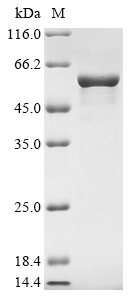Recombinant Human Glial fibrillary acidic protein (GFAP) is expressed in E. coli and includes the complete protein sequence spanning amino acids 1-432. The protein carries an N-terminal 10xHis-tag along with a C-terminal Myc-tag, which streamlines purification and detection processes. SDS-PAGE analysis confirms purity levels above 85%, making this product appropriate for research applications that demand high-quality protein preparations.
Glial fibrillary acidic protein (GFAP) represents a crucial element of the intermediate filament network found in astrocytes. It appears to contribute significantly to structural integrity and proper function within the central nervous system. Scientists frequently examine GFAP for its involvement in neurodevelopment and neurodegenerative conditions. The protein also seems to play an important role in how glial cells respond to injury and serves as a marker indicating astrocyte activation—features that make it particularly valuable in neurological research.
Potential Applications
Note: The applications listed below are based on what we know about this protein's biological functions, published research, and experience from experts in the field. However, we haven't fully tested all of these applications ourselves yet. We'd recommend running some preliminary tests first to make sure they work for your specific research goals.
Based on the provided information, the recombinant Human Glial Fibrillary Acidic Protein (GFAP) is expressed in E. coli, a prokaryotic system that is generally unsuitable for producing properly folded eukaryotic intermediate filament proteins. GFAP requires specific folding and assembly into complex filament structures that typically need eukaryotic chaperones and post-translational modifications unavailable in E. coli. The presence of dual tags (N-terminal 10xHis and C-terminal Myc) may further interfere with proper folding and filament formation. While the protein is full-length (1-432aa) with >85% purity, the E. coli expression system significantly increases the risk of misfolding. Since activity is explicitly unverified, the protein cannot be assumed to be correctly folded or bioactive without experimental validation.
1. Antibody Development and Validation Studies
This application is appropriate. The recombinant GFAP can serve as an effective immunogen for antibody generation. The dual tags provide additional epitopes for characterization. Even if misfolded, antibodies may recognize linear epitopes useful for techniques like Western blotting. However, antibodies may not recognize conformational epitopes of native GFAP if the protein is misfolded. Validation against native GFAP is recommended.
2. Protein-Protein Interaction Studies
This application requires caution. The dual tags enable technical feasibility for pull-down assays, but if GFAP is misfolded, interactions may not be physiological. The protein may not properly interact with authentic binding partners in intermediate filament networks. This application should only be pursued after confirming proper folding through biophysical characterization.
3. Biochemical Characterization and Stability Studies
This application is well-suited and should be prioritized. Techniques like circular dichroism spectroscopy and size-exclusion chromatography can directly assess protein folding and stability. These studies are valuable even if the protein is misfolded, as they characterize the recombinant product itself and can inform about its suitability for other applications.
4. Tag-Based Detection Assay Development
This application is appropriate. The dual tags make this protein useful for developing detection methods using anti-His or anti-Myc antibodies. This application is less dependent on native folding, as tag detection typically works even if the protein is misfolded. The protein can serve as a positive control for methodological development.
Final Recommendation & Action Plan
Given the high probability of misfolding in E. coli, recommend first performing biophysical characterization (e.g., circular dichroism for secondary structure, size-exclusion chromatography for oligomeric state) to assess folding quality. Antibody development and tag-based detection applications can proceed immediately, as they are less conformation-dependent. Protein-protein interaction studies should be deferred until proper folding is validated. For all applications involving biological function, include appropriate controls and validate key findings with native GFAP when possible. Consider alternative eukaryotic expression systems for studies requiring properly folded GFAP with native functionality.






